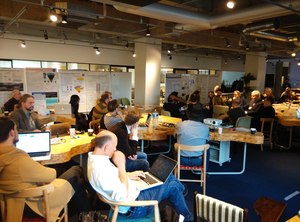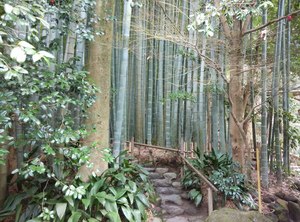ELSI Blog
92 Adventures in Wonderland
 One can ponder endlessly about the nonsense of Lewis Carroll's "Alice's Adventures in Wonderland" -- famous for its crazy unintelligible fantasy world. For me one thing always stood out: Carroll's story of a girl in a land where all encounters and events lack any sensibility makes me wonder about how we make sense of the world and each other in the first place. What are the practices we engage in to make sure that we understand each other? In this sense, my visit to ELSI in Tokyo was a trip down the same rabbit hole. It was a most wonderful experience, and one in which I exercised and appreciated the movement in which people with very different backgrounds understand and engage with each other.
One can ponder endlessly about the nonsense of Lewis Carroll's "Alice's Adventures in Wonderland" -- famous for its crazy unintelligible fantasy world. For me one thing always stood out: Carroll's story of a girl in a land where all encounters and events lack any sensibility makes me wonder about how we make sense of the world and each other in the first place. What are the practices we engage in to make sure that we understand each other? In this sense, my visit to ELSI in Tokyo was a trip down the same rabbit hole. It was a most wonderful experience, and one in which I exercised and appreciated the movement in which people with very different backgrounds understand and engage with each other.
As a graduate student in philosophy and theoretical physics from the University of Amsterdam I was most honored to experience ELSI and the 3rd International ELSI Symposium in January. ELSI as a research institute is a unique breeding ground for thinking about the genesis and development of the earth, other planets, and life upon these. It is hard to grasp the richness of topics I was able to witness during my visit: new updates on Mars exploration; theories of the geodynamics of the early earth; novel approaches to proto-RNA structure; modeling the creation of life-like systems with open-ended evolution, and much more. I felt like a kid in a candy store the days I spent here. I was able to taste of these amazing branches of research, follow their frontiers, and get sucked into the magic of the related origin questions. The ELSI network consists of scientists dealing with the most interdisciplinary of interdisciplinary questions, and most of whom have no effort jumping between scales that differ about 20 orders of magnitude -- no wonder I felt like Alice in Wonderland! Wandering in this scientific landscape, guided by renowned researchers at ELSI, was a magnificent educational experience. But it all came over me with this burning question in the back of my mind: how do scientists in such an interdisciplinary environment, and with such diverse backgrounds manage to understand each other?
A different way to phrase this question is in terms of the fashionable notion of paradigm. In his "The Structures of Scientific Revolution'' (1962) Harvard physicist-turned-historian of science Thomas Kuhn famously introduced this notion in the context of the development of science. These paradigms can be understood as the set of theories, methods, assumptions, instruments and metaphysical principles that form a scientist's world view, and guide every step of his research. History of science consists of many examples of such paradigms -- Newtonian mechanics, relativity theory, Darwinian evolution, the standard model in particle physics, Big Bang theory, etc. -- and science evolves in the succession of these paradigms. An important feature of paradigms, Kuhn argued, is that their fundamentally different underpinnings make different paradigms incommensurable: one cannot simply translate from one to the other. The foundations of two different paradigms is so very different, Kuhn writes, that scientists working in different paradigms cannot communicate. Hence these scientists are fundamentally unable to understand each other, and are in that way living in very different worlds. In essence, every discipline can in this way be understood as having a different paradigm. So how then do these different scientists at ELSI seem to communicate with relative ease on such a sophisticated level?
One of the causes of incommensurability is the different interests and value systems that underlie and guide research. The possible differences in sets of norms and values for me was nowhere more apparent than while visiting ELSI's international institute in Japan. This manifested itself in a number of ways. During my time in Tokyo I had the honor to meet Prof. Takuji Okamoto, a historian of science at the University of Tokyo. Besides discussing his interesting earlier work on Percy Bridgman's doctrine of Operationalism and the establishment of quantum theory in the U.S., Okamoto told me about the Meiji restoration, and how in 1877 the first university in Japan got established. There were right away some inherent differences with the Western university system -- of which the university system was copied. One obvious difference was the introduction of a separate department of agricultural science. Japan was the very first country to have such an independent department, following a demand for this in a time of rapid modernization.
But differences in interests and values can also be less material and explicit. Another Professor of whom I had the honor and pleasure to meet - and share some drinks with! - was Prof. Toru Takahashi, a philosopher of technology at Waseda University. His area of interest is 'cyborg philosophy': he is rethinking humanity and its values in light of the ever-developing use of technology in our daily lives. Takahashi invited me to come to Kamakura to see some of the beautiful temples and shrines in this city. We went on to drink Japanese green tea in the bamboo gardens of the Houkokuji temple, where he told me more about the relation that the Japanese have with technology, and specifically with respect to "virtual reality". He told me that Japanese people have been acquainted with the idea of a virtual reality for many generations. Pointing at the magnificently landscaped garden of the temple, Takahashi mentions that these very gardens are in detail construed as being an alternate reality where Japanese people could spend their time. The temple here is more than 800 years old, but one can easily still recognize the affection with virtual realities in Japan's cosplay and videogame culture -- something I as a seemingly sober Dutchman am less acquainted with.
I indeed very soon realized I was staying in a country with fundamentally different values and virtues -- cultural, ethical, epistemological, or other -- than the ones I grew up with. In this sense, or non-sense I must say, my very stay in Japan itself was also much like experiencing Carroll's imaginary wonderland. Although I hadn't had to deal with grinning cats or crazy tea-parties, I got confronted with phenomena equally unknown to me: comfortably sleeping people in crammed metros; deliberately high-pitched female voices; an enormous amount of vending machines; ticket machines to order my food; raw eggs for breakfast; and, toilets with speakers to produce flush noises. Hence in the same way my very visit felt like an experiment in finding the blurred lines of incommensurability -- how to survive in such an unbelievably different cultural paradigm? How can I ever understand it? And it was all but only material things I had to deal with in understanding. Also on a conceptual level my own paradigm got smacked in the face: I have yet to understand the scope of the notorious, and semantically difficult-to-grasp notions of Moe, Kawaii & Otaku. Furthermore I came across several interesting 'institutional' differences too, like that of Pachinko and the (in)famous AKB48 girl band. Next to conceptually, even physically I sometimes felt to be in the absurd realm of Alice's adventures as I towered over people in my height.
So I wondered, how does ELSI -- a collective of so many different cultures, people and disciplines -- manage to combine both? How do they bring together people from both such different disciplinary and cultural backgrounds in a fruitful way? How do they venture from determinism to stochasticity, from mechanisms to evolutionary teleology? How do they shift from American pragmatism, to Japanese politeness? While I wondered, I had the chance to experience it firsthand. At the coffee machine. During lunch talks. Talking with staff. While having drinks. In meetings. At the worldly tables in the common room. During the evaluation talks. Quite possibly the experiencing part, the activity, is the clue to ELSI's magic. ELSI plays the interdisciplinary game right because they offer it the right playground: a room to play with concepts, theories and values that might collide if not approached correctly. In this way they offer both a fertile physical and conceptual common grounds to leap into the scientific rabbit hole. Hence it is an institute with perfect politeness for each other's discipline and the right pragmatism towards new and old ideas and ideals. In a quest for understanding the very origin of what we are and where we live, it are moreover the quest and questions themselves that bind the people at ELSI -- as much as having a shared conceptual and physical space. Incommensurability or not, ELSI manages to cross so many boundaries in such a pleasant atmosphere that it seems that they are right there in the interdisciplinary Goldilocks zone.
In a similar fashion I appear to have survived my visit to Japan's wonderland, trying to apprehend and adjust to its strange and unfamiliar, yet enthralling and spellbinding culture and customs -- borrowing my approach from ELSI's inspiring environment. It was a genuine honor to be visiting such a thriving intellectual and social environment, where I met so many amazing people and had the opportunity to learn so much, on so many levels!













